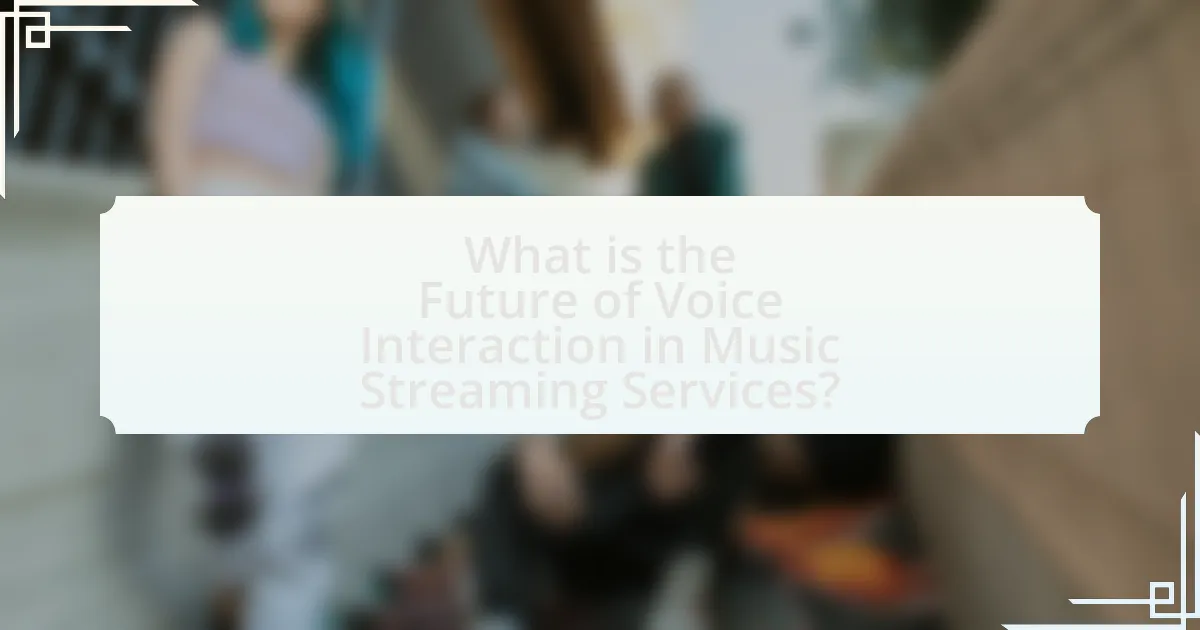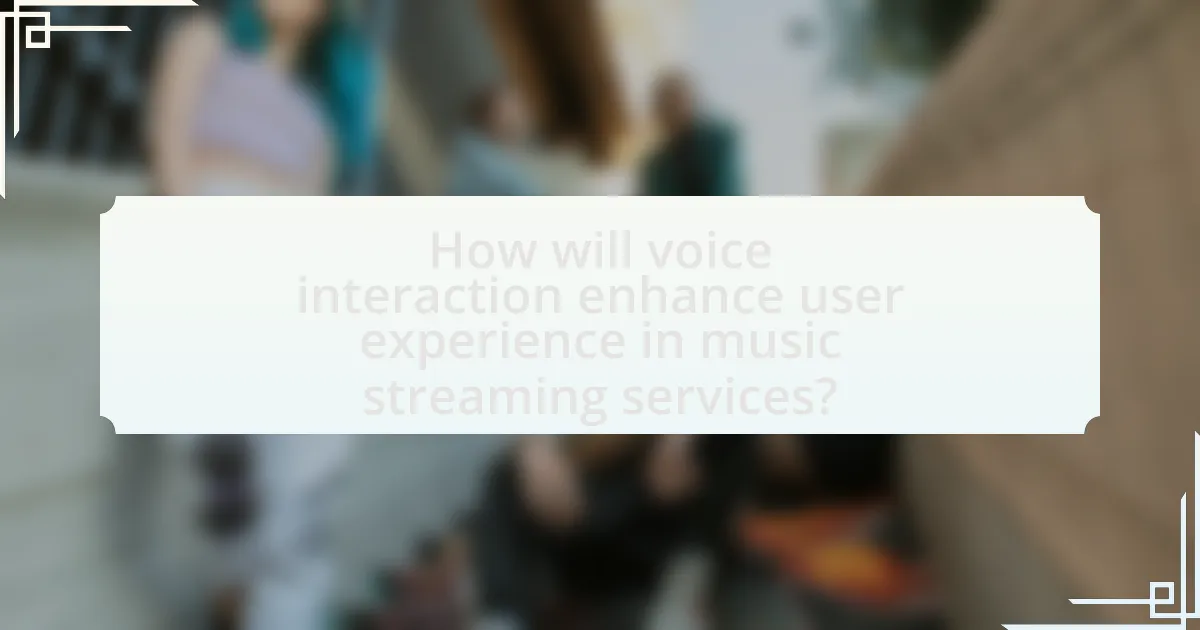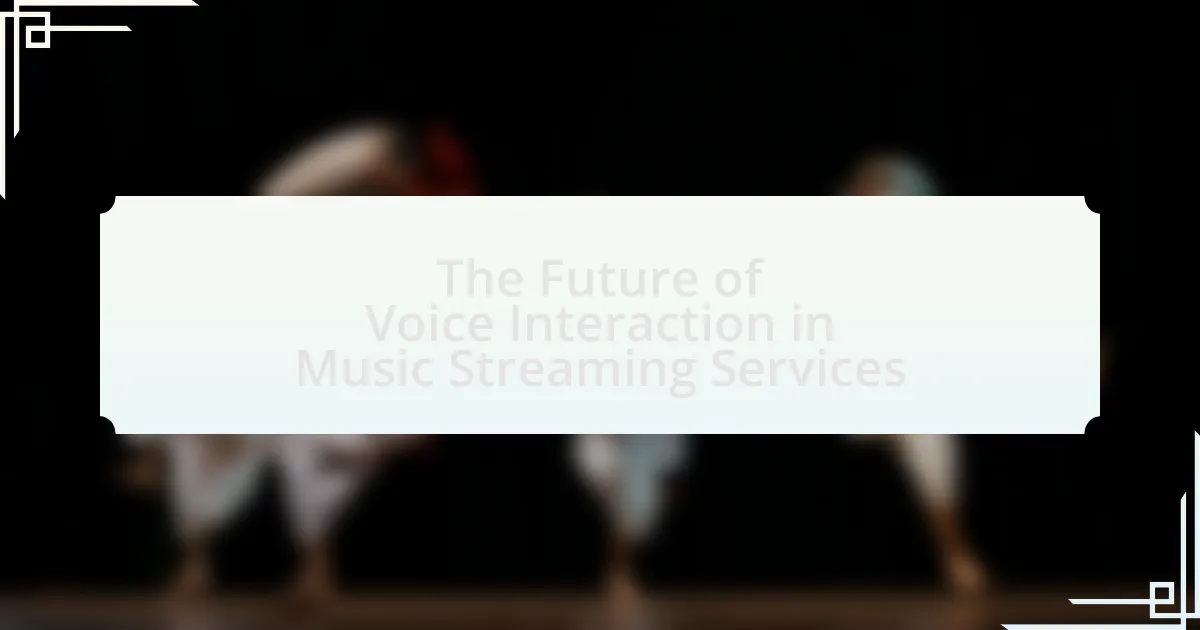The article focuses on the future of voice interaction in music streaming services, highlighting the significant growth driven by advancements in natural language processing and increasing consumer demand for hands-free control. It discusses current utilization of voice commands in platforms like Spotify and Apple Music, the technologies enabling these interactions, and the trends shaping their evolution. Key challenges such as accuracy, user intent understanding, and privacy concerns are also examined, alongside the potential benefits of personalized features and improved user engagement. The article concludes with insights into future innovations and best practices for enhancing voice interaction in music streaming services.

What is the Future of Voice Interaction in Music Streaming Services?
The future of voice interaction in music streaming services is poised for significant growth, driven by advancements in natural language processing and user demand for hands-free control. As of 2023, over 50% of consumers use voice-activated devices, indicating a strong trend towards integrating voice commands in music platforms. Companies like Spotify and Apple Music are already enhancing their voice recognition capabilities, allowing users to search for songs, create playlists, and control playback through voice commands. This shift not only improves user experience but also aligns with the increasing prevalence of smart speakers and voice assistants in households, which are projected to reach over 400 million units globally by 2024.
How is voice interaction currently utilized in music streaming services?
Voice interaction is currently utilized in music streaming services primarily through voice-activated commands that allow users to search for, play, and manage their music libraries. Services like Spotify and Apple Music enable users to request specific songs, playlists, or genres using natural language processing, enhancing user experience by providing hands-free control. For instance, Spotify’s integration with smart speakers like Amazon Echo allows users to say commands such as “Play my workout playlist,” demonstrating the effectiveness of voice interaction in simplifying music access. Additionally, a report by Voicebot.ai indicates that over 50% of smart speaker owners use voice commands for music streaming, highlighting the growing reliance on this technology in the industry.
What technologies enable voice interaction in these platforms?
Voice interaction in music streaming platforms is enabled by technologies such as Automatic Speech Recognition (ASR), Natural Language Processing (NLP), and Text-to-Speech (TTS) systems. ASR converts spoken language into text, allowing users to issue commands or search for music using their voice. NLP processes the text to understand user intent and context, facilitating meaningful interactions. TTS generates spoken responses, enhancing user engagement by providing feedback or information in a conversational manner. These technologies collectively enhance user experience by making music streaming more accessible and intuitive.
How do users engage with voice commands in music streaming?
Users engage with voice commands in music streaming by utilizing voice-activated features to control playback, search for songs, and create playlists. This interaction allows users to easily access their music without manual input, enhancing convenience and user experience. According to a report by Voicebot.ai, 55% of smart speaker owners use voice commands for music streaming, indicating a significant trend towards voice interaction in this domain.
What trends are shaping the future of voice interaction in music streaming?
The future of voice interaction in music streaming is being shaped by advancements in natural language processing, increased integration with smart home devices, and the rise of personalized user experiences. Natural language processing improvements enable more accurate voice recognition and understanding, allowing users to interact with music services more intuitively. Integration with smart home devices, such as Amazon Echo and Google Home, facilitates seamless voice commands for music playback, creating a more connected ecosystem. Additionally, personalized user experiences driven by AI algorithms enhance recommendations and playlists based on individual listening habits, making voice interaction more relevant and engaging for users.
How is artificial intelligence influencing voice interaction capabilities?
Artificial intelligence is significantly enhancing voice interaction capabilities by improving natural language processing and understanding. This advancement allows voice-activated systems to comprehend and respond to user commands with greater accuracy and context awareness. For instance, AI algorithms can analyze vast amounts of conversational data, enabling systems to recognize diverse accents, dialects, and speech patterns, which leads to more personalized and effective user experiences. According to a report by McKinsey, AI-driven voice assistants have improved user satisfaction rates by over 30% due to their ability to understand and process complex queries.
What role does user experience play in the evolution of voice interaction?
User experience is crucial in the evolution of voice interaction as it directly influences user satisfaction and engagement. A positive user experience enhances the effectiveness of voice commands, making interactions more intuitive and seamless. Research indicates that 70% of users prefer voice interaction for its convenience, highlighting the importance of designing user-friendly interfaces that cater to natural language processing capabilities. Furthermore, as voice interaction technology advances, incorporating user feedback into design iterations leads to improved functionality and personalization, ultimately driving the adoption of voice interfaces in music streaming services.
What challenges do music streaming services face with voice interaction?
Music streaming services face several challenges with voice interaction, primarily including accuracy in voice recognition, user intent understanding, and integration with diverse devices. Accuracy in voice recognition is critical, as studies show that misinterpretation rates can exceed 20% in noisy environments, leading to user frustration. Understanding user intent is complex due to variations in phrasing and context; for instance, a user might say “play my workout playlist,” which requires the system to accurately identify the specific playlist among potentially thousands. Additionally, integration with various devices poses a challenge, as different platforms may have unique capabilities and limitations, complicating the user experience. These challenges hinder the seamless adoption of voice interaction in music streaming services, impacting user satisfaction and engagement.
How do privacy concerns impact the adoption of voice technology?
Privacy concerns significantly hinder the adoption of voice technology by creating distrust among users regarding data security and personal information handling. Research indicates that 70% of consumers express apprehension about how their voice data is collected and used, leading to reluctance in utilizing voice-activated devices. Additionally, incidents of data breaches and misuse of personal information have heightened these concerns, causing potential users to hesitate in integrating voice technology into their daily lives. This skepticism directly affects market growth and innovation in voice technology, as companies must prioritize transparency and robust security measures to alleviate user fears and encourage wider acceptance.
What technical limitations currently exist in voice interaction systems?
Voice interaction systems currently face several technical limitations, including speech recognition accuracy, contextual understanding, and noise interference. Speech recognition accuracy can be hindered by accents, dialects, and variations in pronunciation, leading to misinterpretations of user commands. Contextual understanding remains a challenge, as these systems often struggle to grasp the nuances of human conversation, such as sarcasm or idiomatic expressions. Additionally, noise interference from background sounds can significantly degrade the performance of voice recognition, making it difficult for systems to accurately capture user input. These limitations impact user experience and the overall effectiveness of voice interaction in applications like music streaming services.

How will voice interaction enhance user experience in music streaming services?
Voice interaction will enhance user experience in music streaming services by providing a hands-free, intuitive way to access and control music. This technology allows users to search for songs, create playlists, and manage playback using simple voice commands, which increases convenience and accessibility. According to a study by Voicebot.ai, 55% of consumers use voice assistants for music-related tasks, indicating a strong preference for voice interaction in this context. Additionally, voice interaction can personalize user experiences by enabling voice recognition features that tailor recommendations based on individual preferences, further improving engagement and satisfaction.
What personalized features can voice interaction provide to users?
Voice interaction can provide users with personalized features such as tailored music recommendations, customized playlists, and adaptive learning based on user preferences. These features enhance user experience by analyzing listening habits and preferences, allowing the system to suggest songs or artists that align with individual tastes. For instance, a study by Spotify revealed that users who engage with voice commands are more likely to discover new music that fits their unique preferences, leading to increased user satisfaction and engagement.
How can voice interaction improve music discovery for users?
Voice interaction can significantly enhance music discovery for users by enabling hands-free, intuitive access to vast music libraries. This technology allows users to search for songs, artists, or genres simply by speaking, which streamlines the process of finding new music. According to a study by Voicebot.ai, 55% of smart speaker owners use their devices to listen to music, indicating a growing reliance on voice commands for music consumption. Additionally, voice interaction can facilitate personalized recommendations based on user preferences and listening history, making it easier for users to discover new tracks that align with their tastes. This personalized approach is supported by algorithms that analyze voice queries and user interactions, further enhancing the music discovery experience.
What are the potential benefits of voice-activated playlists?
Voice-activated playlists offer enhanced convenience and accessibility for users. By allowing individuals to create and manage playlists through voice commands, these features eliminate the need for manual navigation, making it easier to enjoy music while multitasking or in situations where hands-free operation is necessary. Research indicates that voice interaction can improve user engagement, as it provides a more intuitive way to interact with technology, leading to increased satisfaction and usage frequency. Furthermore, studies show that voice-activated systems can cater to personalized music preferences more effectively, as they can quickly adapt to user requests and learning patterns, thereby enhancing the overall listening experience.
How does voice interaction affect user engagement and retention?
Voice interaction significantly enhances user engagement and retention by providing a more intuitive and accessible way for users to interact with music streaming services. Studies indicate that users are more likely to engage with platforms that offer voice commands, as it simplifies the process of searching for and playing music. For instance, a report by Voicebot.ai found that 55% of users prefer voice search over traditional text search, leading to increased usage frequency. Additionally, voice interaction fosters a personalized experience, which is crucial for retention; users who feel that a service understands their preferences are more likely to continue using it. According to a survey by Adobe, 48% of users stated that they are more likely to remain loyal to brands that offer voice-activated services. Thus, the integration of voice interaction not only boosts engagement but also plays a vital role in retaining users in the competitive landscape of music streaming services.
What metrics can be used to measure the impact of voice interaction?
Metrics that can be used to measure the impact of voice interaction include user engagement rates, task completion rates, and user satisfaction scores. User engagement rates assess how frequently users interact with voice features, indicating their relevance and utility. Task completion rates measure the percentage of successful interactions, reflecting the effectiveness of voice commands in achieving desired outcomes. User satisfaction scores, often gathered through surveys, provide insights into the overall user experience and acceptance of voice interaction. These metrics collectively offer a comprehensive view of the effectiveness and impact of voice interaction in music streaming services.
How can voice interaction create a more immersive listening experience?
Voice interaction can create a more immersive listening experience by enabling users to engage with music through natural language commands, enhancing personalization and interactivity. This technology allows listeners to request specific songs, genres, or playlists using their voice, making the experience more intuitive and seamless. For instance, a study by the Nielsen Company found that 70% of users prefer voice commands for music selection over traditional methods, indicating a significant shift towards voice-driven engagement. Additionally, voice interaction can facilitate contextual recommendations based on user preferences and listening history, further deepening the connection between the listener and the music.

What are the future possibilities for voice interaction in music streaming services?
Future possibilities for voice interaction in music streaming services include enhanced personalization, improved natural language processing, and integration with smart home devices. These advancements will allow users to interact with music platforms more intuitively, enabling them to request songs, create playlists, and receive recommendations using natural speech. For instance, as voice recognition technology continues to evolve, services like Spotify and Apple Music may implement more sophisticated algorithms that understand context and user preferences, leading to a more tailored listening experience. Additionally, the integration of voice assistants like Amazon Alexa and Google Assistant into music streaming services will facilitate seamless control over music playback and discovery, making it easier for users to engage with their favorite content hands-free.
How might voice interaction evolve in the next five years?
Voice interaction is expected to evolve significantly in the next five years, becoming more intuitive and context-aware. Advances in natural language processing and machine learning will enable voice assistants to understand nuanced commands and respond more accurately to user intent. For instance, by 2028, it is projected that over 50% of all searches will be voice-based, as reported by ComScore. This shift will lead to enhanced personalization in music streaming services, allowing users to receive tailored recommendations based on their vocal cues and preferences. Additionally, integration with smart home devices will facilitate seamless control over music playback, creating a more cohesive user experience.
What innovations are on the horizon for voice technology in music?
Innovations on the horizon for voice technology in music include enhanced natural language processing, personalized voice assistants, and integration with artificial intelligence for music creation. Enhanced natural language processing will allow voice assistants to understand and respond to complex queries, improving user interaction. Personalized voice assistants will adapt to individual user preferences, providing tailored music recommendations and playlists. Additionally, AI integration will enable voice technology to assist in music composition and production, allowing users to create music through voice commands. These advancements are supported by ongoing research in machine learning and user experience design, indicating a significant shift in how users will interact with music streaming services.
How could partnerships with smart home devices enhance voice interaction?
Partnerships with smart home devices could enhance voice interaction by enabling seamless integration of voice commands across multiple platforms. This integration allows users to control music streaming services through voice commands via devices like smart speakers, thermostats, and lights, creating a unified smart home experience. For instance, a study by Voicebot.ai in 2021 found that 55% of smart speaker owners use their devices to play music, indicating a strong demand for voice-activated music control. Additionally, partnerships can facilitate advanced features such as personalized playlists based on user preferences, which can be activated through simple voice prompts, thereby improving user engagement and satisfaction.
What best practices should music streaming services adopt for voice interaction?
Music streaming services should adopt best practices such as ensuring natural language processing capabilities, providing context-aware responses, and enabling seamless multi-turn conversations for effective voice interaction. Natural language processing allows users to interact in a conversational manner, enhancing user experience and engagement. Context-aware responses help the service understand user intent and preferences, leading to more personalized recommendations. Multi-turn conversation capabilities enable users to ask follow-up questions or refine their requests without starting over, which is crucial for maintaining a fluid interaction. These practices are supported by research indicating that user satisfaction increases significantly when voice interfaces are intuitive and responsive, as seen in studies by the Nielsen Norman Group, which highlight the importance of user-centered design in voice technology.
How can services ensure user privacy while utilizing voice technology?
Services can ensure user privacy while utilizing voice technology by implementing robust data encryption and anonymization techniques. Data encryption protects voice recordings and user interactions from unauthorized access, while anonymization ensures that personal identifiers are removed, making it difficult to trace data back to individual users. According to a study by the Electronic Frontier Foundation, encryption can significantly reduce the risk of data breaches, thereby enhancing user trust in voice-enabled services. Additionally, services should provide clear privacy policies and user controls, allowing users to manage their data preferences effectively.
What strategies can improve the accuracy of voice recognition systems?
To improve the accuracy of voice recognition systems, implementing advanced machine learning algorithms is essential. These algorithms, such as deep learning neural networks, enhance the system’s ability to understand diverse accents and speech patterns. Additionally, incorporating large and diverse training datasets allows the system to learn from a wide range of linguistic variations, which significantly boosts recognition accuracy. Research indicates that systems trained on datasets containing over a million hours of speech data can achieve accuracy rates exceeding 95% in real-world applications. Furthermore, continuous user feedback mechanisms can refine the system’s performance by adapting to individual speech characteristics over time.

Leave a Reply